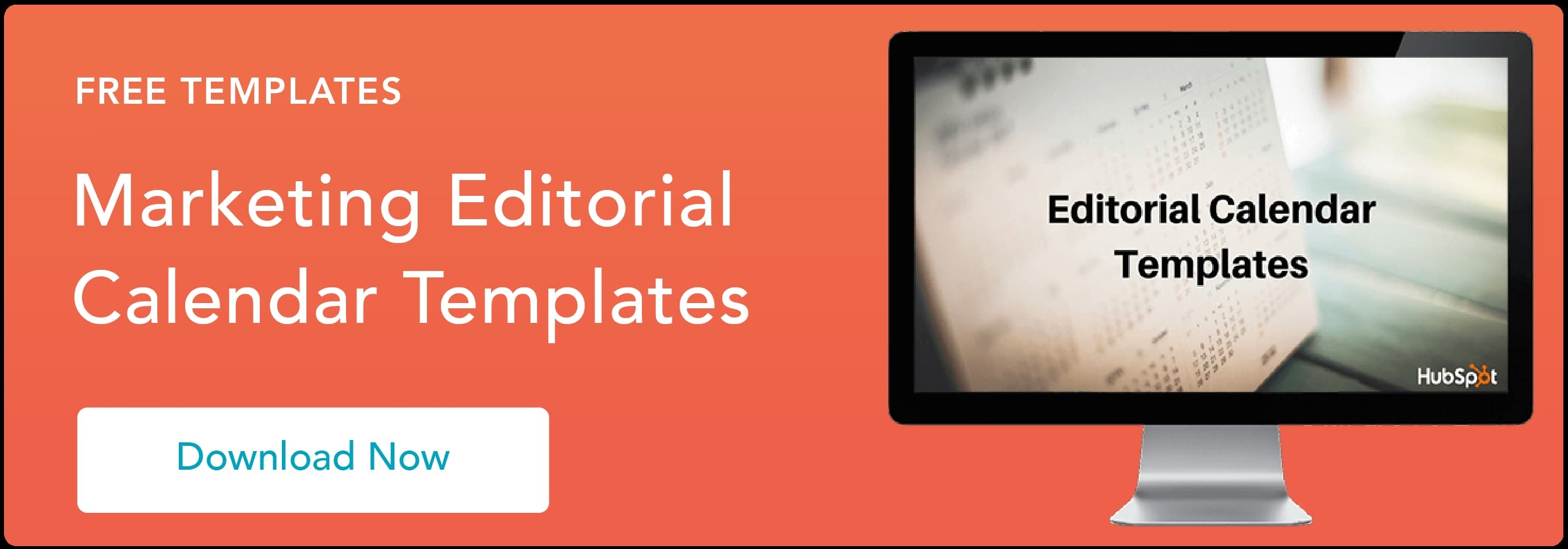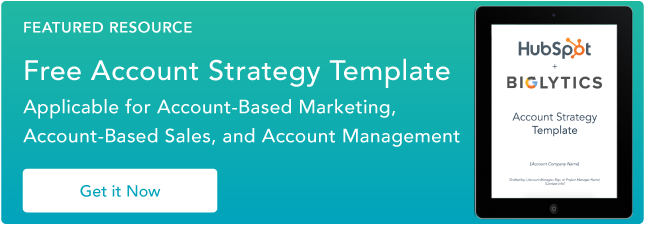Whether on Facebook Messenger, their website, or even text messaging, more and more brands are leveraging chatbots to service their customers, market their brands, and even sell their products.
But, the if/then logic that powers many chatbots’ conversational abilities limits them from answering unique and new questions, which can hang your customer out to dry and leave them dissatisfied with your customer service — luckily, AI-powered chatbots that can solve that problem are gaining steam.
In this post, we’ll discuss what AI chatbots are and how they work and outline 18 of the best AI chatbots to know about.
The rise of generative AI and language models like GPT and LaMDA (the podcast below discusses how they work) has made way for conversational AI chatbots with advanced capabilities that can mimic a human conversation style, find information online, and produce unique content.
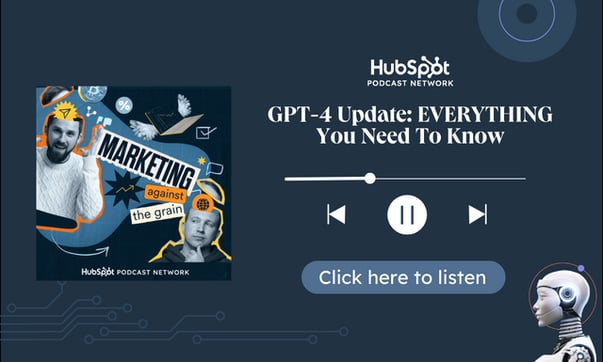 Click here to listen to the full episode
Click here to listen to the full episode
The most important thing to know about an AI chatbot is that it combines ML and NLU to understand what people need and bring the best solutions. Some AI chatbots are better for personal use, like conducting research, and others are best for business use, like featuring a chatbot on your website.
Conversational AI vs Chatbots
Conversational AI and chatbots are related, but they are not exactly the same.
Conversational AI is a broader term that encompasses chatbots, virtual assistants, and other AI-generated applications. It refers to an advanced technology that allows computer programs to understand, interpret, and respond to natural language inputs.
Although AI chatbots are an application of conversational AI, not all chatbots are programmed with conversational AI. For instance, rule-based chatbots use simple rules and decision trees to understand and respond to user inputs. Unlike AI chatbots, rule-based chatbots are more limited in their capabilities because they rely on keywords and specific phrases to trigger canned responses.
Use Cases for AI Chatbots
AI chatbots are used in a wide range of applications across many industries, helping businesses streamline operations and increase productivity, provide better user experiences, and improve customer service. Here are some ways you can use AI chatbots to enhance processes within your organization:
Customer Support
- Provide 24/7 support to your customers
- Address FAQs
- Solve simple issues through a chat interface
Sales and Marketing
- Answer initial inquiries about products and services
- Provide recommendations
- Help customers with purchase decisions
Writing and Editing
- Generate content ideas
- Create article outlines
- Draft emails, social copy, and paragraphs
Recruitment and HR
- Engage with potential job candidates
- Answer basic questions about open positions
- Schedule interviews and meetings
Benefits of AI Chatbots
Having an AI chatbot on your company website can bring numerous benefits, no matter what industry you’re in. Here are a few key advantages:
Improved Customer Experience
AI Chatbots provide instant responses, personalized recommendations, and quick access to information. Additionally, they are available round the clock, enabling your website to provide support and engage with customers at any time, regardless of staff availability.
Efficiency
As your business grows, handling customer queries and requests can become more challenging. AI chatbots can handle multiple conversations simultaneously, reducing the need for manual intervention. This ensures faster response times and improves overall efficiency. Plus, they can handle a large volume of requests and scale effortlessly, accommodating your company’s growth without compromising on customer support quality.
Data Gathering and Analysis
AI Chatbots can collect valuable customer data, such as preferences, pain points, and frequently asked questions. This data can be used to improve marketing strategies, enhance products or services, and make informed business decisions.
Lead Generation and Support
AI Chatbots can qualify leads, provide personalized experiences, and assist customers through every stage of their buyer journey. This helps drive more meaningful interactions and boosts conversion rates.
With this in mind, we’ve compiled a list of the best AI chatbots for 2023. Read on to find the right one for you.
1. ChatSpot
Price: Free
 Get Started with ChatSpot for Free
Get Started with ChatSpot for Free
ChatSpot is HubSpot’s new conversational CRM bot. It combines the capabilities of ChatGPT with unique data sources to help your business grow. You can input your own queries or use one of ChatSpot’s many prompt templates, which can help you find solutions for content writing, research, SEO, prospecting, and more.
 For example, I prompted ChatSpot to write a follow-up email to a customer asking about how to set up their CRM.
For example, I prompted ChatSpot to write a follow-up email to a customer asking about how to set up their CRM.
Though ChatSpot is free for everyone, you experience its full potential when using it with HubSpot. It can help you automate tasks such as saving contacts, notes, and tasks. Plus, it can guide you through the HubSpot app and give you tips on how to best use its tools.
Key Features
- Chat-based commands help sales, marketing, and service professionals maximize productivity
- Draft follow-up emails, compile analytics reports, or even prospect
- Connects to HubSpot software and leverages your existing data
2. ChatGPT
Price: Free; ChatGPT Plus: $20/month
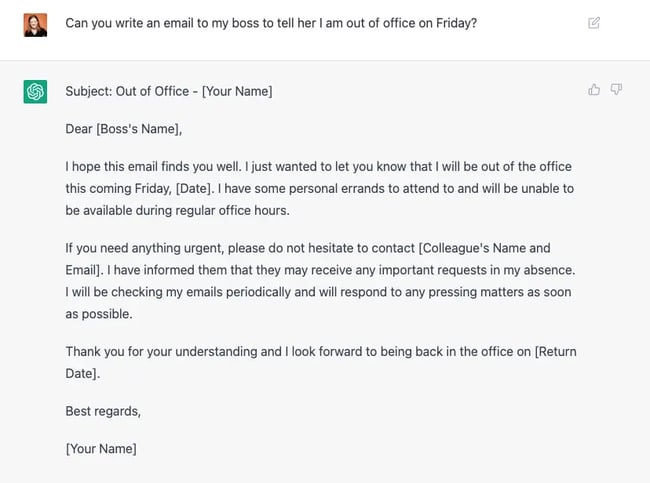
ChatGPT is OpenAI’s conversational chatbot powered by GPT-3.5 and GPT-4. It uses a standard chat interface to communicate with users, and its responses are generated in real-time through deep learning algorithms, which analyze and learn from previous conversations.
Because ChatGPT was pre-trained on a massive data collection, it can generate coherent and relevant responses from prompts in various domains such as finance, healthcare, customer service, and more. In addition to chatting with you, it can also solve math problems, as well as write and debug code.
Both free and paid users of ChatGPT can enjoy unlimited usage. However, ChatGPT Plus subscribers get to enjoy a few extra perks that free users do not have, such as exclusive access to GPT-4, priority access during peak times, and faster response speeds.
Key Features
- Uses natural language processing to understand the context of conversations to provide related and original responses in a human-like conversation
- Multiple use cases for things like answering simple questions, ideating and getting inspiration, or generating new content (like a marketing email)
- Improves over time as it has more conversations
3. Bing Chat
Price: Free (requires Microsoft Edge)
Microsoft describes Bing Chat as an AI-powered co-pilot for when you conduct web searches. It expands the capabilities of search by combining the top results of your search query to give you a single, detailed response. Plus, it cites the sources from where it gets its information.
Bing also has an image creator tool where you can prompt it to create an image of anything you want. You can even give details such as adjectives, locations, or artistic styles so you can get the exact image you envision.
To get the most out of Bing, be specific, ask for clarification when you need it, and tell it how it can improve. You can also ask Bing questions on how to use it so you know exactly how it can help you with something and what its limitations are.
Key Features
- Uses NLP and machine learning to understand conversation prompts
- The compose feature can generate original written content and images, and its powerful search engine capabilities can surface answers from the web
- It’s a conversational tool, so you can continue sending messages until you’re satisfied
4. Bard
Price: Free
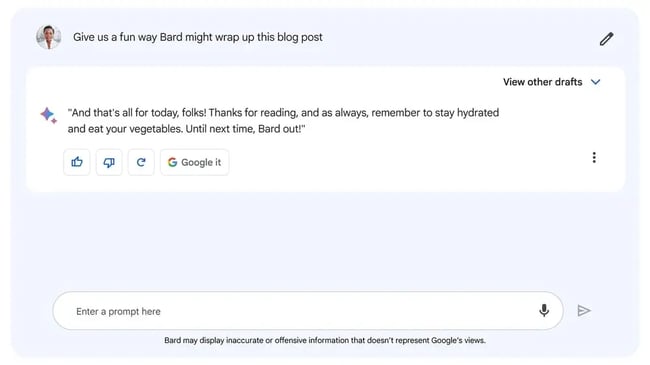
Google’s Bard is a multi-use AI chatbot — it can generate text and spoken responses in over 40 languages, create images, code, answer math problems, and more.
One of Bard’s strengths is that it is great with text. You can use it to write and edit things, such as emails, resumes, and cover letters. Because it’s created by Google, it also features a “Google it” button to help you learn more about a given topic as well as exports to other Google products, like Google Docs and Gmail.
Despite its impressive capabilities, Bard has faced criticisms for providing false and misleading information, especially compared to ChatGPT.
Key Features
- Powered by Google’s PaLM-2 (instead of GPT)
- Use it for things like brainstorming and ideation, drafting unique and original content, or getting answers to your questions
- Connected to Google’s website index so it can access information from the internet
5. Jasper Chat
Price: Starts at $39/month
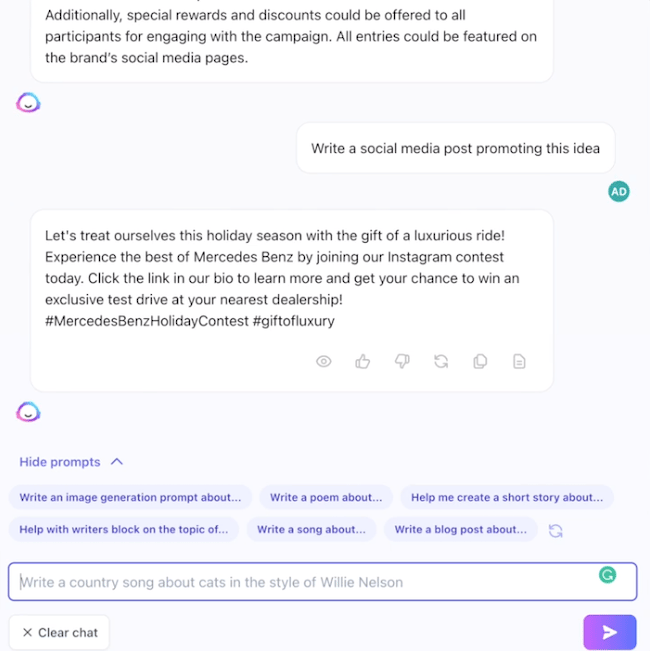
Jasper Chat is built with businesses in mind and allows users to apply AI to their content creation processes. It can help you brainstorm content ideas, write photo captions, generate ad copy, create blog titles, edit text, and more.
Unlike ChatGPT, Jasper pulls knowledge straight from Google to ensure that it provides you the most accurate information. It also learns your brand’s voice and style, so the content it generates for you sounds less robotic and more like you.
Key Features
- Proprietary AI engine sourced from OpenAI and other models.
- Wide breadth of knowledge on niche and elaborate topics.
- Remembers and learns from previous conversations.
6. Perplexity
Price: Free; Pro: $20/month
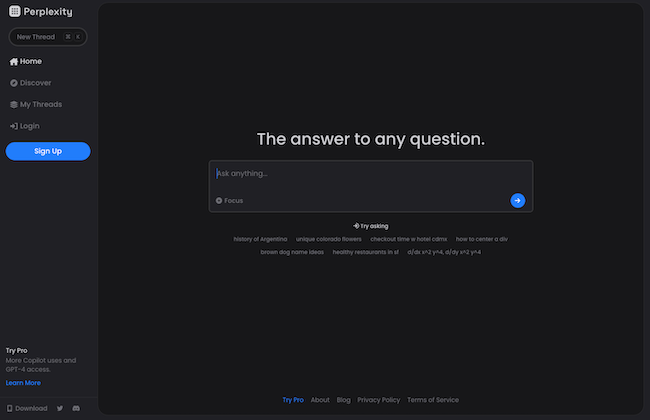
Powered by GPT-3.5, Perplexity is an AI chatbot that acts as a conversational search engine. It’s designed to provide users simple answers to their questions by compiling information it finds on the internet and providing links to its source material.
With no set-up required, Perplexity is pretty easy to access and use. Just simply go to the website or mobile app and type your query into the search bar, then click the blue button. From there, Perplexity will generate an answer, as well as a short list of related topics to read about.
Key Features
- Provides links to sources and generates related queries for further reading.
- Focus setting allows you to narrow your results from specific sources for different purposes, such as WolframAlpha for computational queries or Reddit for discussions and opinions.
- Allows you to save search threads and share them with others.
Note: The six chatbots mentioned above are conversational and generative bots best suited for internal business use for things like ideating, producing content, and getting answers to your queries. Below we’ll go over AI chatbots that are customer-facing.
7. Tidio Lyro
Price: Starts at $29/month
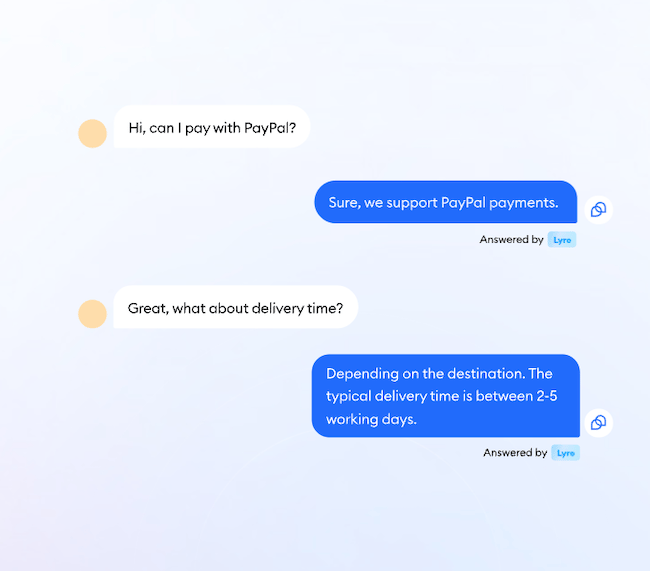
Lyro is a conversational AI chatbot created with small and medium businesses in mind. It helps free up the time of customer service reps by engaging in personalized conversations with customers for them.
Lyro instantly learns your company’s knowledge base so it can start resolving customer issues immediately. It also stays within the limits of the data set that you provide in order to prevent hallucinations. And if it can’t answer a query, it will direct the conversation to a human rep.
Key Features
- Provides human-like answers to frequently asked questions.
- Keeps a record of redirected questions so that you can add them to your knowledge base later on.
- Asks customers follow up questions to ensure satisfaction.
8. Kommunicate
Price: Start: $40/mo; Grow: $100/mo; Business: Custom Pricing
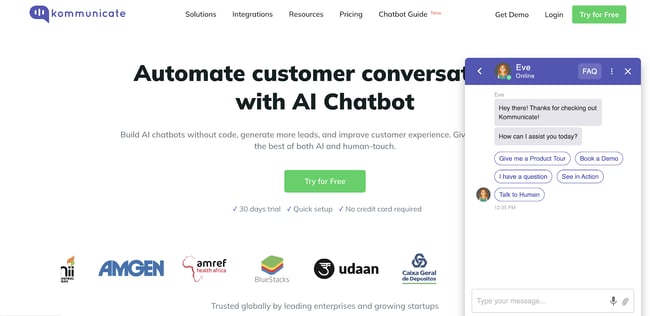
Kommunicate is a human + Chatbot hybrid platform designed to help businesses improve customer engagement and support.
The platform helps businesses build chatbots and manage customer interactions across multiple channels, including website chat, messenger apps, and email.
Although you can train your Kommunicate chatbot on various intents, it is designed to automatically route the conversation to a customer service rep whenever it can’t answer a query.
Key Features
- Conversational AI and NLP capabilities, which allow businesses to automate aspects of customer support, such as answering frequently asked questions or routing customers to the right support agent.
- Offers a range of integration options, allowing businesses to seamlessly incorporate it into their existing workflows.
- Provides advanced analytics and reporting capabilities, allowing businesses to track and analyze customer interactions and support metrics.
9. HubSpot Chatbot Builder
Price: Free
Free Chatbot Builder Software
HubSpot has a powerful and easy-to-use chatbot builder that allows you to automate and scale live chat conversations.
Keep in mind that HubSpot‘s chat builder software doesn’t quite fall under the “AI chatbot” category of “AI chatbot” because it uses a rule-based system. However, HubSpot does have code snippets, allowing you to leverage the powerful AI of third-party NLP-driven bots such as Dialogflow.
Key Features
- Customers can get answers to frequently asked questions, book meetings, and navigate through your site.
- Conversations are stored in your CRM so you can qualify leads and trigger automation flows.
- Easy integration across your marketing, sales, and service tools because HubSpot is a CRM platform.
10. Intercom Fin
Price: $0.99/resolution (requires Intercom subscription, which starts at $74/month)
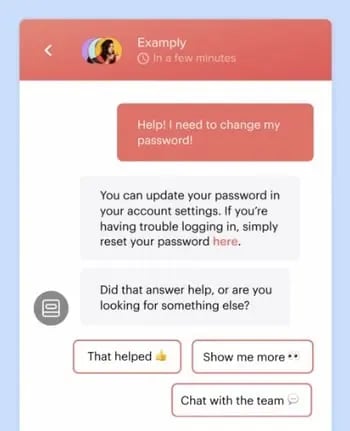
Fin is Intercom’s conversational AI platform, designed to help businesses automate conversations and provide personalized experiences to customers at scale.
Built on ChatGPT, Fin allows companies to build their own custom AI chatbots using Intercom’s tools and APIs. It uses your company’s knowledge base to answer customer queries and provides links to the articles in references.
In addition to having conversations with your customers, Fin can ask you questions when it doesn’t understand something. When it isn’t able to provide an answer to a complex question, it flags a customer service rep to help resolve the issue.
Key Features
- Built-in safeguards to ensure it only provides accurate responses to customer questions.
- Fin Conversations allows you to easily view Fin’s interactions with customers from your inbox.
- Create custom answers to FAQs that get prioritized over AI generated answers.
11. Watson Assistant
Price: Free – $140/month
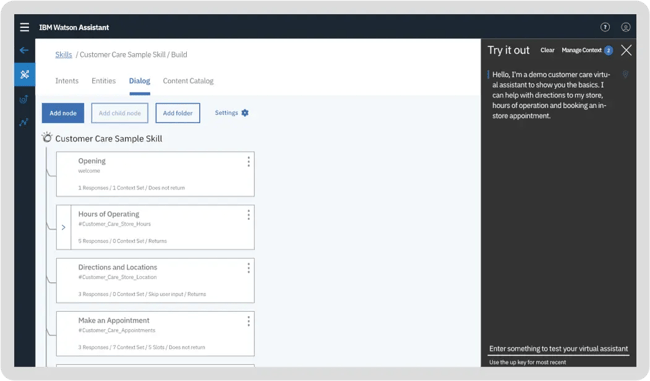
IBM Watson Assistant is an AI-powered conversational bot that gives you impressive recommendations for further training so it gets better at its job. Its intent recommendations flag topic clusters that should be added to the database, while its entity recommendations identify existing topics that need more depth.
Watson Assistant is trained with data that is unique to your industry and business so it provides users with relevant information. It can run on your website, messaging channels, customer service tools, and mobile app. Plus, you can quickly get started with the low-code chat builder.
Key Features
- NLP and machine learning to gather context.
- Integrates with multiple systems and databases to access information.
- Analytics and insights to monitor user interactions, understand user behavior, and improve overall performance.
12. Drift
Price: Contact for pricing
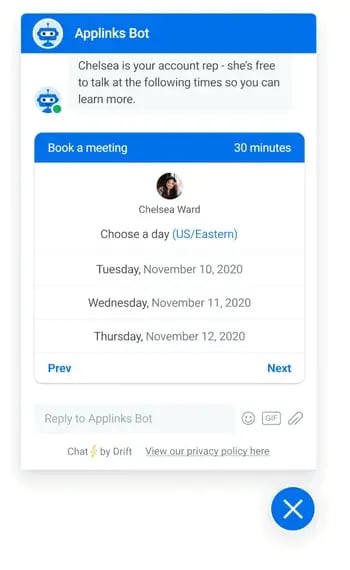
Drift is an automation-powered conversational bot to help you communicate with site visitors based on their behavior. With its intent detection capabilities, Drift can interpret open-ended questions, determine what information users are looking for, and provide them with a relevant answer or route the conversation to the appropriate team.
Drift’s AI technology enables it to personalize website experiences for visitors based on their browsing behavior and past interactions. It can also seamlessly book meetings and qualify leads.
In addition to its chatbot, Drift’s live chat features use GPT to provide suggested replies to customers queries based on their website, marketing materials, and conversational context.
Key Features
- Rule-based and AI chatbot with a classifier that categorizes conversations by context for more meaningful conversations.
- Can handle context switching if the conversation flow or subject changes.
- Customizable chat widget for mobile and desktop with helpful out-of-the-box integrations.
13. Infobip
Price: Contact for pricing
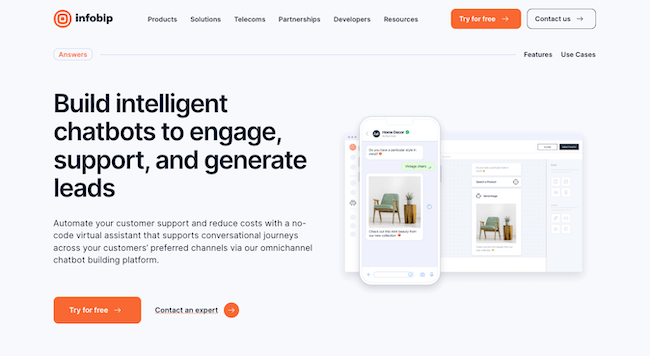
Infobip’s chatbot building platform, Answers, helps you design your ideal conversation flow with a drag-and-drop builder. It allows you to create both rules-based and intent-based chatbots, with the latter using AI and NLP to recognize user intent, process information, and provide a human-like conversational experience.
Infobip also has a generative AI-powered conversation cloud called Experiences that is currently in beta. In addition to the generative AI chatbot, it also includes customer journey templates, integrations, analytics tools, and a guided interface.
Key Features
- AI and machine learning help you train your chatbot.
- Rule and intent-based bots that understand the context of and replicate a conversational experience.
- Omnichannel usability for WhatsApp, Facebook Messenger, Etc.
14. Appy Pie Chatbot
Price: Starts at $6 per bot/month
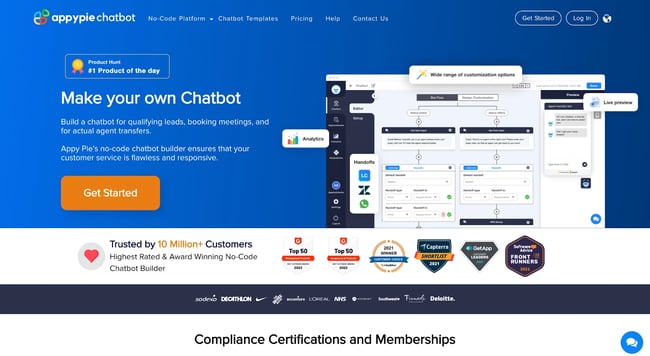
Appy Pie helps you design a wide range of conversational chatbots with a no-code builder.
Appy Pie’s Chatbot Builder simplifies the process of creating and deploying chatbots, allowing businesses to engage with customers, automate workflows, and provide support without the need for coding. The customizable templates, NLP capabilities, and integration options make it a user-friendly option for businesses of all sizes.
Appy Pie also has a GPT-4 powered AI Virtual Assistant builder, which can also be used to intelligently answer customer queries and streamline your customer support process.
Key Features
- GPT-3 powered intuitive chatbot with contextual understanding.
- Leverages your business data to give accurate results to queries.
- Deploy a chatbot on your website or mobile app.
15. Zendesk Answer Bot
Price: Starts at $55per agent/month
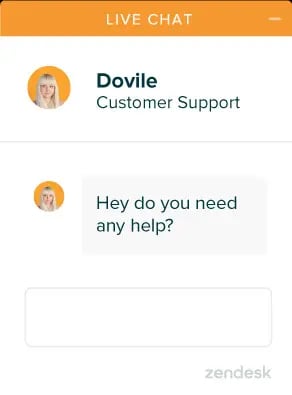
Zendesk Answer Bot integrates with your knowledge base and leverages data to have quality, omnichannel conversations. Zendesk’s no-code Flow Builder tool makes creating customized AI chatbots a piece of cake. Plus, it’s super easy to make changes to your bot so you’re always solving for your customers.
Each Zendesk Suite plan includes standard chatbot capabilities. However, you can access Zendesk’s Advanced AI with an add-on to your plan for $50 per agent/month. The add-on includes advanced bots, intelligent triage, intelligent insights and suggestions, and macro suggestions for admins.
Key Features
- Use Flow Builder to create custom AI-powered conversation flows.
- Deep learning capabilities to contextualize conversations and understand intent.
- Escalation to live agents who get insights and suggestions from AI to bring quick solutions.
16. Salesforce Einstein
Price: Available through cloud products
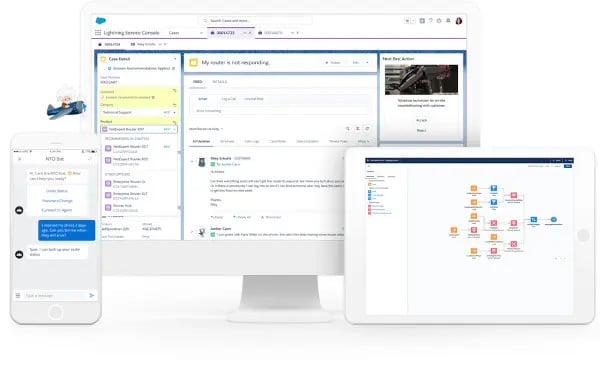
Salesforce Einstein is a conversational bot that natively integrates with all Salesforce products. It can handle common inquiries in a conversational manner, provide support, and even complete certain transactions. Plus, it is multilingual so you can easily scale your customer service efforts all across the globe.
Einstein Bots seamlessly integrate with Salesforce Service Cloud, allowing Salesforce users to leverage the power of their CRM. Bots can access customer data, update records, and trigger workflows within the Service Cloud environment, providing a unified view of customer interactions.
Key Features
- Powered by predictive intelligence and machine learning.
- Builds contextual understanding and leverages existing Salesforce data to surface the best responses.
- Routing to human agents for more pressing conversations.
17. LivePerson
Price: Contact for pricing
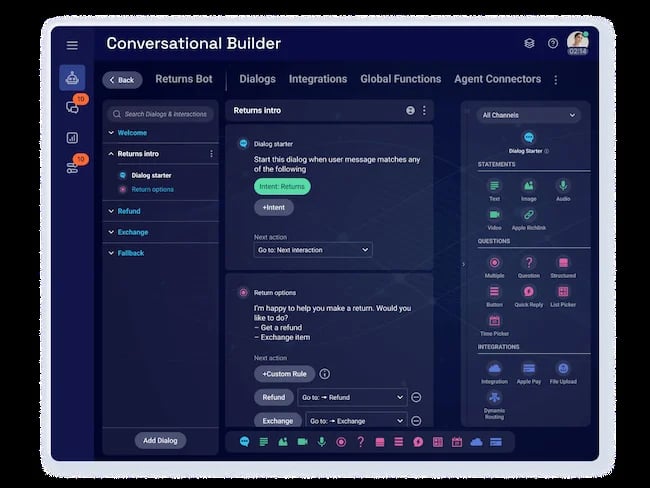
LivePerson’s AI chatbot is built on 20+ years of messaging transcripts. It can answer customer inquiries, schedule appointments, provide product recommendations, suggest upgrades, provide employee support, and manage incidents.
This AI chatbot can support extended messaging sessions, allowing customers to continue conversations over time without losing context. When needed, it can also transfer conversations to live customer service reps, ensuring a smooth handoff while providing information the bot gathered during the interaction.
Key Features
- The intent manager leverages data to understand the context of conversations.
- Create automated conversation flows across different messaging channels (website, mobile app, Apple Business Chat, etc.)
- Point and click builder to quickly and seamlessly create your bot.
18. Ada
Price: Contact for pricing
Ada is an automated AI chatbot with support for 50+ languages on key channels like Facebook, WhatsApp, and WeChat. It’s built on large language models (LLMs) that allow it to recognize and generate text in a human-like manner.
The drag-and-drop chat builder requires zero coding and offers smart suggestions to help quickly train your chatbot. That way, you can spend less time on fine-tuning your chatbot, and more time on deep work.
Key Features
- Uses pre-trained machine learning models that you can refine to meet your business needs.
- Intent detection understands context and uses profiles and metadata to personalize conversations.
- Connected to your business’ crucial data to bring appropriate solutions.
Want to learn more about artificial intelligence? Check out this learning path.
Editor’s note: This post was originally published in March 2019 and has been updated for comprehensiveness.
![]()


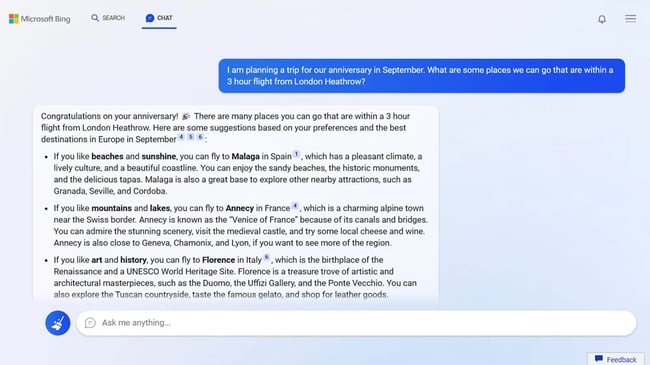
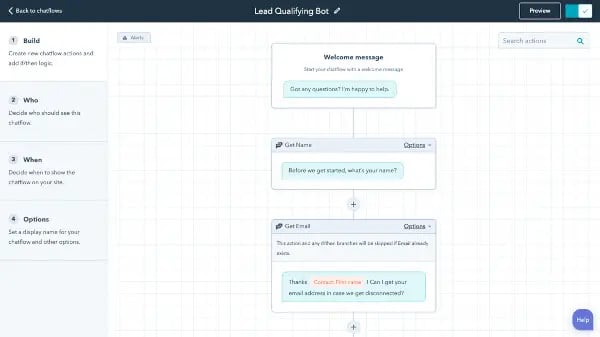
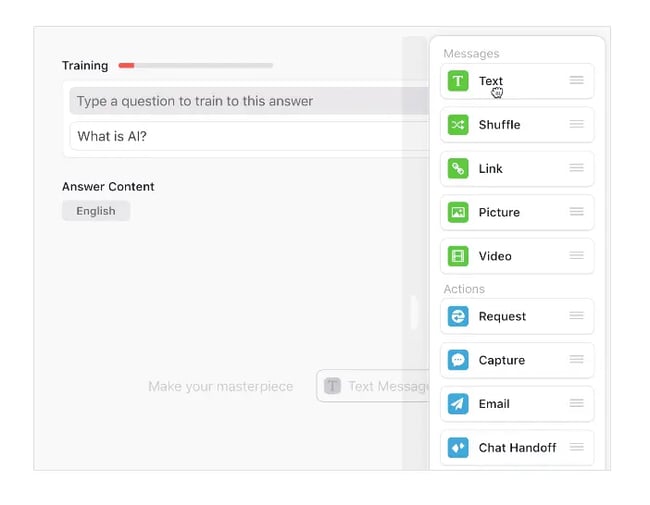





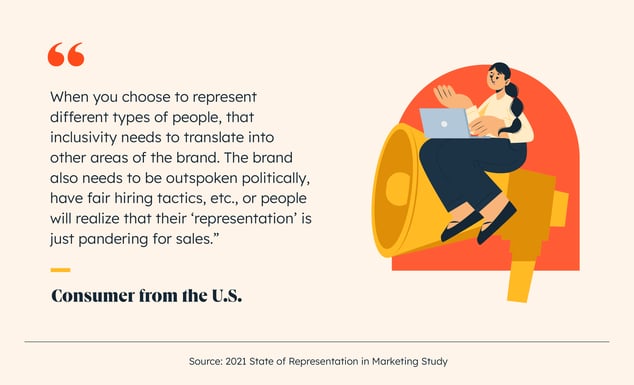
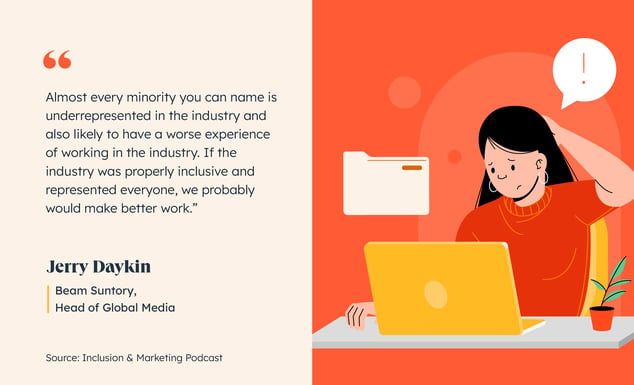


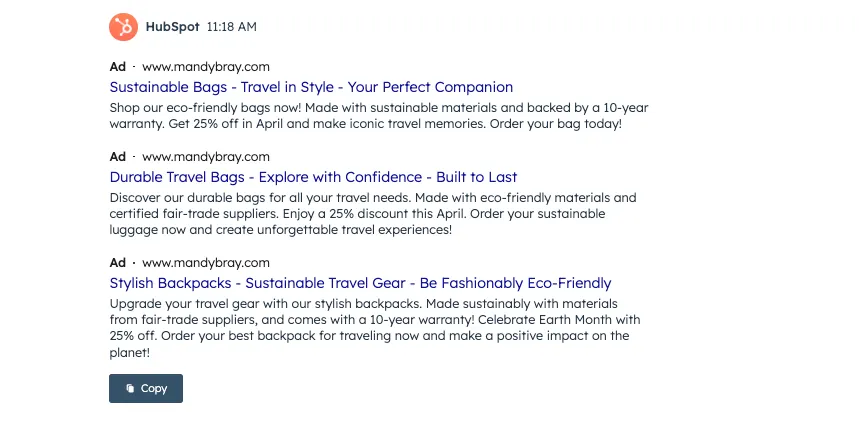

![→ Download Now: 12 Resume Templates [Free Download]](https://i4lead.com/wp-content/uploads/2023/11/4ec95757-585e-40cf-9189-6b3885074e98.png)



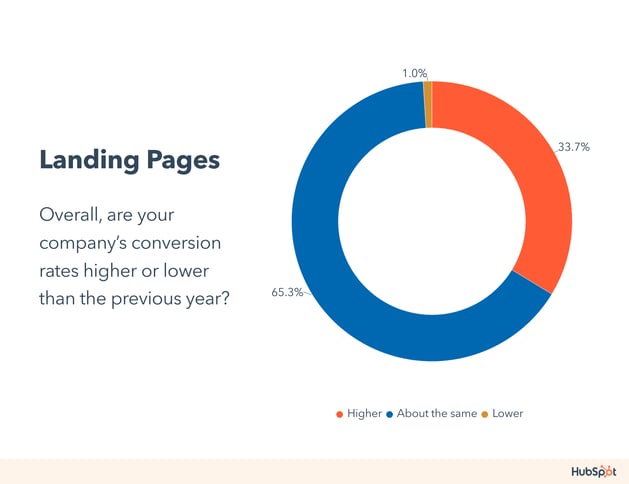

 The interesting part? Popups make up about 66% of all signup forms. Compare that to landing pages that make up 5.1% of all signup forms, and what you see is an opportunity to create more landing pages and maximize conversions.
The interesting part? Popups make up about 66% of all signup forms. Compare that to landing pages that make up 5.1% of all signup forms, and what you see is an opportunity to create more landing pages and maximize conversions.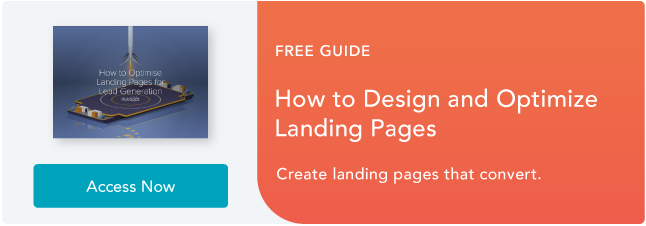

![Download Now: 50+ Remote Team-Building Activities [Free Ebook]](https://i4lead.com/wp-content/uploads/2023/11/204394e2-023a-45c8-a6eb-d5dd263640b2.png)
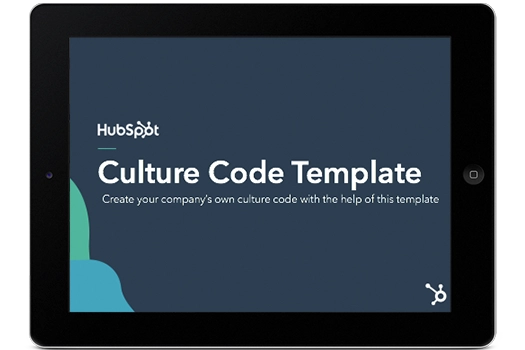



![Download Now: Free Marketing Plan Template [Get Your Copy]](https://i4lead.com/wp-content/uploads/2023/11/aacfe6c7-71e6-4f49-979f-76099062afa0.png)


